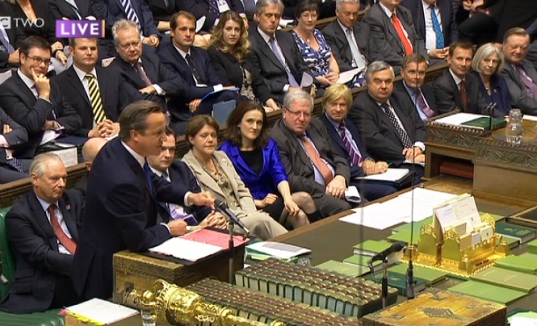Does a swing to the right help or hinder the Tories?

David Herdson wonders if the nature of the “floater” is changing
Much comment has been made about the apparent shift to the right in the Conservative Party that the reshuffle represented. Before looking at that, it’s worth noting that this was David Cameron acting as Conservative leader rather than Prime Minister: the Lib Dems’ responsibilities at cabinet level remained utterly unchanged in portfolio and personnel.
-
As the parliament wears on, the government resembles less and less a unified coalition and more an agreed division of spheres of influence.
To that end, was there a shift to the right and if so, does it matter? To the first part, the answer is probably yes, but not by as much as was made out at the time. Ken Clarke being replaced by Chris Grayling sounds a dramatic swing from one wing of the Tory Party to the other. In one sense it is, but given the work Grayling (and IDS – Cameron’s first choice for Justice Secretary) has been doing at Work and Pensions on social exclusion and marginalisation, the focus may not be quite so traditionally right-wing as first supposed.
Does it matter? As so often in politics, the answer is that it depends. It’s frequently said that elections are won in the centre ground and by and large, that’s probably been the case. Even so, just because something has been true doesn’t mean it always will be, particularly if the nature of the electorate and / or the political system changes.
And change it has been doing. There are now perhaps five (overlapping) groups of swing voters which the parties have to successfully target in order to be successful.
There remain firstly the traditional centre-ground floaters, driven mainly by pragmatic considerations such as competence, a government’s delivery in office and an opposition’s likely performance if elected. They’re far less interested in ideology and indeed are distrustful of and often turned off by grand plans and theorising. This group has always been seen as key to winning and is usually the subject of the most intense campaigning, both in terms of promises and of rubbishing the other side.
A subset of these floaters are the Liberal Persuadables. Many centre-ground floaters won’t consider the Lib Dems except if local circumstances give them a chance of winning. If you are interested in electing a government (by proxy), then it usually makes sense to vote for one of the parties most likely to do so. Not all though: some stop off half way.
There is a third group of Con/Lab switchers who fit less easily into the centre ground: the Collectivist Social Conservatives. Instinctively left-wing on economic issues but right-wing on social ones, they’ve traditionally been open to voting Blue or Red (but far less frequently Yellow).
Here though is one point where the old rules are close to inadequate. At one time – up to the 1990s probably – members of this group would vote and would still vote mainly Labour or Tory. The increasing professionalisation of politics and its recapture by the middle class (and hence the parties becoming more socially liberal) has left such voters behind. There are now two increasingly important groups who don’t fit into the old model.
The first is the Minor Party Drifters. Whether UKIP, Green, BNP, nationalist in Scotland or Wales, or some other party (Respect in Bradford West, for example), there are far more parties on offer to cater for the disillusioned. The old argument that a party could sit in the centre and rely on the more hard left/right to still support them because they ‘have nowhere else to go’ no longer applies. There is no point chasing centrist floaters if you are haemorrhaging what was once your core.
The second is the Potential Abstainers. Turnout in general elections dropped slowly from a high point in the 1950s but fell off a cliff after 1997 and only recovered a little in 2010. Two Potential Abstainers are worth one switcher, but there are far more potential abstainers.
The net result of all this is that it’s far harder now for parties to keep a grip on the coalition that forms their support base, particularly in a time of increased cynicism. Voters can be lost in any number of directions – but by the same token, they can also be won back from any number of directions. Effectiveness in the centre ground still matters – apart from anything else, such voters make their minds up on things like perceived competence and likeability; factors which matter strongly to other swing voters too (which indicates that it‘s not actually being in the centre ground per se that matters but being seen to be good managers and not too risky – ending up in the centre ground is an effect, not a cause). That said, it’s a bigger game now and to win, parties have to guard both their flanks. With UKIP consistently polling in high single figures, a targeted swing to the right is probably a necessary – but far from sufficient – condition for the Conservatives to stand a chance of winning in 2015.